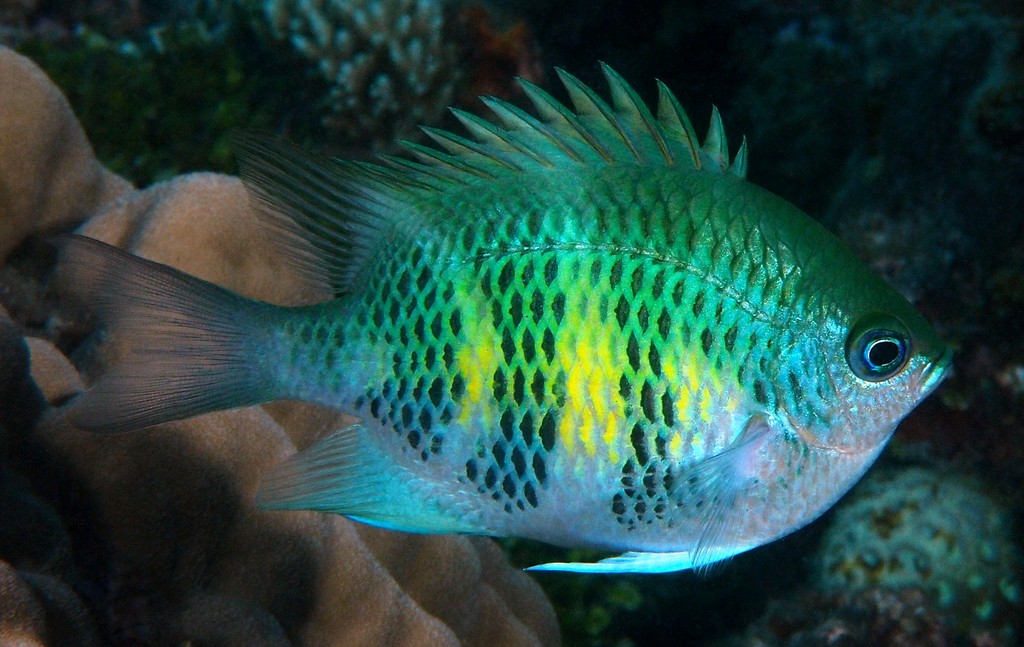AMBLYGLYPHIDODON CURACAO - (BLOCH, 1787)
Actinopterygii (Gigaclass) > Actinopteri (Class) > Teleostei (Subclass) > Blenniiformes (Order) > Pomacentridae (Family) > Pomacentrinae (Subfamily) > Amblyglyphidodon (Genus)
Demoiselle des cornes de cerf, Black-snouted sergeant-major, Clouded damselfish, Staghorn damsel, Staghorn damselfish, Staghorn sergeant, Kurakao-suzumedai, クラカオスズメダイ, 库拉索豆娘鱼, 橘鈍寬刻齒雀鯛, 庫拉索凹牙豆娘魚,
Synonymes
Abudefduf curacao (Bloch, 1787)
Amblygliphidodon curacao (Bloch, 1787)
Amblyglyphidodon curaco (Bloch, 1787)
Amblyglyphisodon nudirostrum (Fowler, 1944)
Ambyglyphidodon curacao (Bloch, 1787)
Chaetodon curacao (Bloch, 1787)
Glyphisodon smaragdinus (Brevoort, 1856)
Glyphisodon trifasciatus (Bleeker, 1847)
---------------------------
Description
Dorsal spines (total): 13; Dorsal soft rays (total): 12-13; Anal spines: 2; Anal soft rays: 13-15; Pectoral rays: 17-18; Lateral-line scales: 16-17; Gill rakers: 24-27; Body depth: 1.6-1.7 in SL. Max length: 11.0 cm TL. Depth range: 1 - 40 m, usually: 1 - 15 m.
Demoiselle des cornes de cerf, Black-snouted sergeant-major, Clouded damselfish, Staghorn damsel, Staghorn damselfish, Staghorn sergeant, Kurakao-suzumedai, クラカオスズメダイ, 库拉索豆娘鱼, 橘鈍寬刻齒雀鯛, 庫拉索凹牙豆娘魚,
Synonymes
Abudefduf curacao (Bloch, 1787)
Amblygliphidodon curacao (Bloch, 1787)
Amblyglyphidodon curaco (Bloch, 1787)
Amblyglyphisodon nudirostrum (Fowler, 1944)
Ambyglyphidodon curacao (Bloch, 1787)
Chaetodon curacao (Bloch, 1787)
Glyphisodon smaragdinus (Brevoort, 1856)
Glyphisodon trifasciatus (Bleeker, 1847)
---------------------------
Description
Dorsal spines (total): 13; Dorsal soft rays (total): 12-13; Anal spines: 2; Anal soft rays: 13-15; Pectoral rays: 17-18; Lateral-line scales: 16-17; Gill rakers: 24-27; Body depth: 1.6-1.7 in SL. Max length: 11.0 cm TL. Depth range: 1 - 40 m, usually: 1 - 15 m.
Color
A greenish to yellowish damselfish with three or four broad greyish bars on sides. Several geographical variations. Indonesian populations green with dusky bars when adult. Irian Jaya fish maybe more silvery with greenish bars that ranges from Japan to eastern Australia. The caudal fin has a black margin. The underside is paler.
Etymology
Amblyglyphidodon: from Greek, amblys or amblus = dull (blade: not sharp), blunt, obtuse + from Greek, glyphis = carved + from Greek, odous = teeth.
curacao: for the type locality, curacao (island country in the southern Caribbean Sea) or for it's colors.
Original description: Chaetodon curacao Bloch, 1787 - Type locality: South America, Curaçao Island (in error, probably western Pacific or East Indies).
Distribution
Eastern Indian Ocean, western Pacific: Cocos-Keeling and Christmas islands (eastern Indian Ocean), Malaya (Malaysia) and Indonesia east to Marshall Islands and Samoa, north to Ryukyu Islands and Kagoshima Prefecture (southern Japan), south to northern Australia and New Caledonia.
Biology
Adults inhabit lagoons, coastal embayments, reef passages and outer reefs. Juveniles often found among Sarcophyton and Sinularia soft corals. Feeding aggregations are frequently observed over growths of the staghorn coral Acropora. Feed on zooplankton and filamentous algae. The stomach contents of a specimen included larval crabs and shrimps, fish eggs, and algae. Oviparous, distinct pairing during breeding. Eggs are demersal and adhere to the substrate. Males guard and aerate the eggs.
Etymology
Amblyglyphidodon: from Greek, amblys or amblus = dull (blade: not sharp), blunt, obtuse + from Greek, glyphis = carved + from Greek, odous = teeth.
curacao: for the type locality, curacao (island country in the southern Caribbean Sea) or for it's colors.
Original description: Chaetodon curacao Bloch, 1787 - Type locality: South America, Curaçao Island (in error, probably western Pacific or East Indies).
Distribution
Eastern Indian Ocean, western Pacific: Cocos-Keeling and Christmas islands (eastern Indian Ocean), Malaya (Malaysia) and Indonesia east to Marshall Islands and Samoa, north to Ryukyu Islands and Kagoshima Prefecture (southern Japan), south to northern Australia and New Caledonia.
Biology
Adults inhabit lagoons, coastal embayments, reef passages and outer reefs. Juveniles often found among Sarcophyton and Sinularia soft corals. Feeding aggregations are frequently observed over growths of the staghorn coral Acropora. Feed on zooplankton and filamentous algae. The stomach contents of a specimen included larval crabs and shrimps, fish eggs, and algae. Oviparous, distinct pairing during breeding. Eggs are demersal and adhere to the substrate. Males guard and aerate the eggs.
Last update: 29, August 2022
